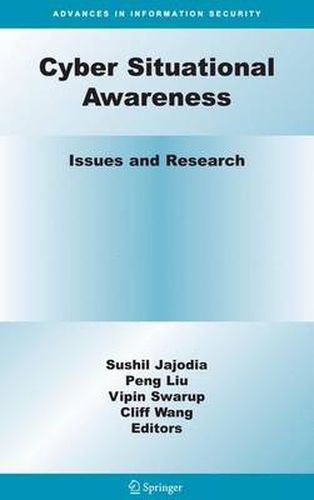Readings Newsletter
Become a Readings Member to make your shopping experience even easier.
Sign in or sign up for free!
You’re not far away from qualifying for FREE standard shipping within Australia
You’ve qualified for FREE standard shipping within Australia
The cart is loading…






This title is printed to order. This book may have been self-published. If so, we cannot guarantee the quality of the content. In the main most books will have gone through the editing process however some may not. We therefore suggest that you be aware of this before ordering this book. If in doubt check either the author or publisher’s details as we are unable to accept any returns unless they are faulty. Please contact us if you have any questions.
Motivation for the Book This book seeks to establish the state of the art in the cyber situational awareness area and to set the course for future research. A multidisciplinary group of leading researchers from cyber security, cognitive science, and decision science areas elab orate on the fundamental challenges facing the research community and identify promising solution paths. Today, when a security incident occurs, the top three questions security admin istrators would ask are in essence: What has happened? Why did it happen? What should I do? Answers to the ?rst two questions form the core of Cyber Situational Awareness. Whether the last question can be satisfactorily answered is greatly de pendent upon the cyber situational awareness capability of an enterprise. A variety of computer and network security research topics (especially some sys tems security topics) belong to or touch the scope of Cyber Situational Awareness. However, the Cyber Situational Awareness capability of an enterprise is still very limited for several reasons: * Inaccurate and incomplete vulnerability analysis, intrusion detection, and foren sics. * Lack of capability to monitor certain microscopic system/attack behavior. * Limited capability to transform/fuse/distill information into cyber intelligence. * Limited capability to handle uncertainty. * Existing system designs are not very friendly to Cyber Situational Awareness.
$9.00 standard shipping within Australia
FREE standard shipping within Australia for orders over $100.00
Express & International shipping calculated at checkout
This title is printed to order. This book may have been self-published. If so, we cannot guarantee the quality of the content. In the main most books will have gone through the editing process however some may not. We therefore suggest that you be aware of this before ordering this book. If in doubt check either the author or publisher’s details as we are unable to accept any returns unless they are faulty. Please contact us if you have any questions.
Motivation for the Book This book seeks to establish the state of the art in the cyber situational awareness area and to set the course for future research. A multidisciplinary group of leading researchers from cyber security, cognitive science, and decision science areas elab orate on the fundamental challenges facing the research community and identify promising solution paths. Today, when a security incident occurs, the top three questions security admin istrators would ask are in essence: What has happened? Why did it happen? What should I do? Answers to the ?rst two questions form the core of Cyber Situational Awareness. Whether the last question can be satisfactorily answered is greatly de pendent upon the cyber situational awareness capability of an enterprise. A variety of computer and network security research topics (especially some sys tems security topics) belong to or touch the scope of Cyber Situational Awareness. However, the Cyber Situational Awareness capability of an enterprise is still very limited for several reasons: * Inaccurate and incomplete vulnerability analysis, intrusion detection, and foren sics. * Lack of capability to monitor certain microscopic system/attack behavior. * Limited capability to transform/fuse/distill information into cyber intelligence. * Limited capability to handle uncertainty. * Existing system designs are not very friendly to Cyber Situational Awareness.